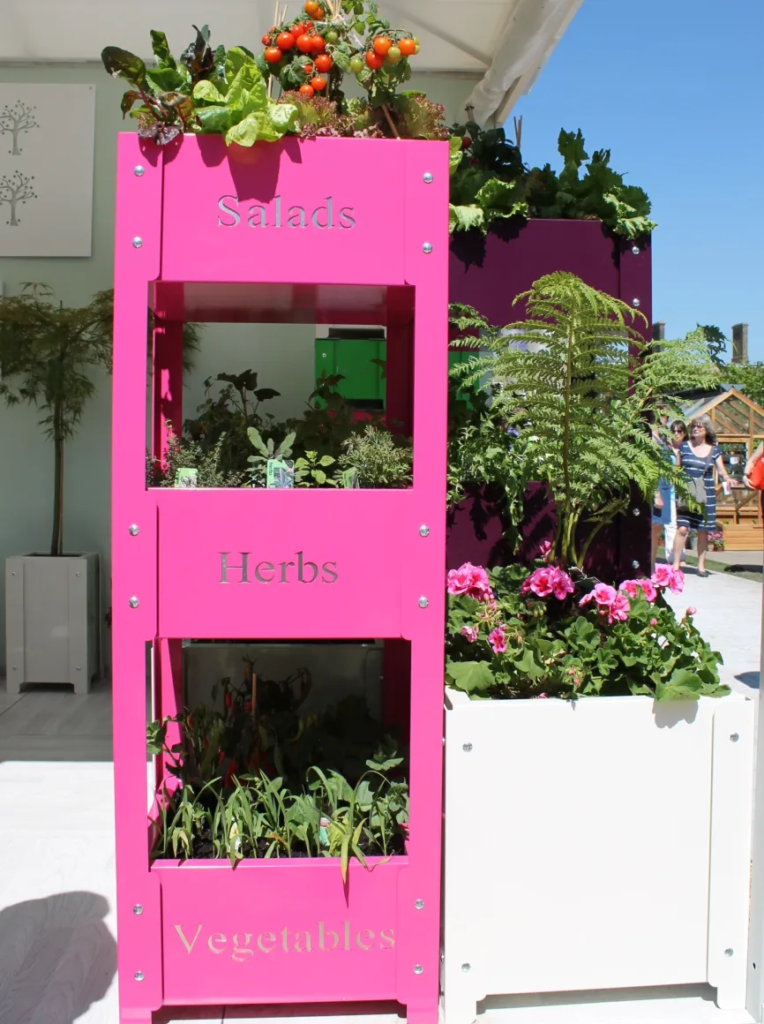Today we are going to see some ideas to make a mini vegetable garden at home. There are many options of containers for mini vegetable gardens, so even if you live in a city and don’t have a garden you don’t have to give up having a home urban garden.

We will see several types of small vertical gardens and other ideas to make a vegetable garden on the balcony or in the garden at home without taking up too much space. A small balcony, a patio, or even a window sill is enough to make a mini urban garden.
As we will see, you can buy prefabricated structures, make your own containers or use recycled materials for the mini urban garden.
Contents
What is a mini organic garden
In this type of urban gardens it is very important to respect the principles of organic farming (among them to do without synthetic fertilizers and chemical insecticides and replace them with natural products).
In order to harvest 100% organic, natural and chemical-free products, in the mini garden we will always use organic fertilizers or composts, such as compost or worm castings, and integrated pest management methods (such as pest traps or homemade insecticides made with plants) instead of chemical products.

In addition, interspersing plants of different types that have benefits over each other (the technique known as Crop Association) is another alternative to more aggressive traditional measures.
How to make a mini vegetable garden at home: tricks to cultivate in small spaces
The first thing to do to make a mini vegetable garden at home is to decide the plants that we are going to grow, since depending on that we will choose the containers and pots for the home vegetable garden.
There are plants that need more depth than others, so we will also have to choose the plants for the mini garden thinking about the space we have.

If we have the possibility of making a vegetable garden in the garden at home we can put larger plants, such as peppers, tomatoes, pumpkins or watermelons. If, on the other hand, we are going to cultivate a vegetable garden on the balcony or a mini vertical garden, we will choose smaller plants such as garlic, lettuce, spinach, strawberries, aromatic herbs…
Mini Vertical Vegetable Gardens
If you want to make a vegetable garden in a patio without much light, vertical gardens can be a very good option because you will take better advantage of the hours of sun that can reach the place.

In addition, the vertical garden can also be the solution if you want to grow in a terrace or small garden where you can not afford a garden that takes too much space. There are many types of vertical gardens, from a mini vertical garden with pallets (like the one in the photo above right), to hanging planters.
Another example of a mini vertical garden are the modular vertical planters, composed of several independent containers or growing bags.


If you want to make an inexpensive vegetable garden you will like these other ideas to make a mini vertical vegetable garden with recycled materials. You can use, for example, reused fruit crates and recycled plastic drums as growing containers, or, as in the image below right, make a vertical vegetable garden with recycled plastic bottles.
Mini vegetable garden on the balcony or rooftop terrace
If you have one or more balconies or a roof terrace on the upper floor, you can place mini urban gardens in these areas of the house. There are many types!

For balcony gardens, elongated containers (such as rectangular planters) and pots fit very well, as they can be interspersed to make the best use of space.
The containers for the mini vegetable garden can be of many types and materials: wood, plastic, ceramic or even recycled materials such as the polystyrene planter in the image below.

Geotextile sacks or containers are also very suitable for urban gardening. These bags to cultivate adapt well to any space, which is an advantage when we do not have much room, as is the case of the garden on the balcony.
Vegetable garden on the patio or in the garden at home
If we have a little more space to make the urban garden, a very comfortable alternative are the cultivation tables.

If we install cultivation tables we will not have to bend down to work in the urban garden. They are also easier to move from one place to another and many are equipped with wheels.

To make a vegetable garden in a patio or in the garden at home, you can combine several types of mini-gardens: on cultivation tables, in terraces, mini-gardens in planters, with recycled materials…
Mini indoor vegetable garden
If what you want is an indoor vegetable garden, it is best to choose plant species that can grow with little direct light, such as aromatic herbs, celery, radishes or lettuce.

The options are almost as many as in the outdoor garden, you can make a vegetable garden, a vertical garden….
The most important thing is to make sure that the plants of the indoor vegetable garden we choose can grow without much light (vegetables such as solanaceae -tomato, bell pepper, eggplant…-, or cucurbits such as zucchini, for example, would not be suitable for this type of urban vegetable garden as they require many hours of direct sunlight).

Another alternative for the mini indoor vegetable garden is to install a grow cabinet at home in an area near the windows.
We can make a nice combination of vegetables, aromatic plants and flowers in this type of display cabinet to grow, and boast of having a real decorative garden at home.
Finally, we should mention something a little more novel in indoor gardens: the growing cabinets with spotlight and automatic irrigation. For much more money, yes, but with these cabinets we can make a small kitchen garden without worrying too much about watering or the light that reaches the plants.

In addition to home gardens, this technology of applying LED light to increase crop yields is being studied with very positive results in the field of intensive agricultural production in controlled environments. Thus, this type of indoor cultivation could become an alternative to supply the growing demand for food on the planet in the future, if, as it seems and unfortunately, we continue to pollute the soil and resources of the planet.

